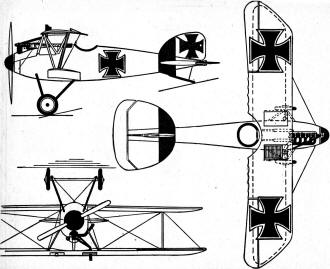|
The February 1942 issue of
Flying Aces magazine contained a quadruplet of 3-view scale drawings of early
airplanes: The German
Fokker D.V Albatros
fighter biplane, the American Army Air Force's
Douglas O-31A observation
monoplane, the
Ryan Navy
Seaplane, and Russian
I-16 Mosca fighter low wing monoplane. Per Wikipedia, "The
Albatros D.V was a fighter aircraft built by the Albatros Flugzeugwerke
and used by the Luftstreitkräfte (Imperial German Air Service) during World War
I. The D.V was the final development of the Albatros D.I family and the last Albatros
fighter to see operational service. Despite its well-known shortcomings and general
obsolescence, approximately 900 D.V and 1,612 D.Va aircraft were built before production
halted in April 1918." Here is an official
outline drawing of the Albatros. Oddly, the drawing
in Flying Aces labels this as a
Fokker D.III, which looks nothing like the D.V. (the D.III
looks more like a Sopwith Camel)
Albatros D III Pursuit
 Next to the Fokker D.7 the D.V Albatros
was the most popular fighter-pursuit ship to be used during the latter part of World
War 1. Employing plywood monococque construction in the fuselage and mounting a
175 h.p. Mercedes engine, the best the Albatros could do at top speed was 120 m.p.h.
It cruised at 90. Twin synchronized Spandau machine guns were mounted on top of
the fuselage cowl. Span of upper wing was 29 feet 8 inches. Lower wing, 28 feet
9 inches. Over all length was 24 feet. Suggested color scheme: White fuselage and
wings, black crosses as shown, with red band around the tail, covering the front
of the vertical fin. Struts should be clear hard wood, streamlined. Next to the Fokker D.7 the D.V Albatros
was the most popular fighter-pursuit ship to be used during the latter part of World
War 1. Employing plywood monococque construction in the fuselage and mounting a
175 h.p. Mercedes engine, the best the Albatros could do at top speed was 120 m.p.h.
It cruised at 90. Twin synchronized Spandau machine guns were mounted on top of
the fuselage cowl. Span of upper wing was 29 feet 8 inches. Lower wing, 28 feet
9 inches. Over all length was 24 feet. Suggested color scheme: White fuselage and
wings, black crosses as shown, with red band around the tail, covering the front
of the vertical fin. Struts should be clear hard wood, streamlined.
Posted October 26, 2019
|